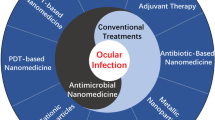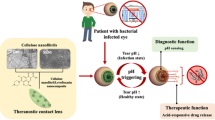Abstract
Recommended as a medical emergency, infectious keratitis with an acute and rapid disease progression can lead to serious damage of vision and even blindness. Herein, we present a kind of theranostic agents, which are made of vancomycin (Van)-modified fluorescent silicon nanoparticles (SiNPs-Van), enabling rapid and non-invasive diagnosis and treatment of Gram-positive bacteria-induced keratitis in a simultaneous manner. Typically, the resultant SiNPs-Van nanoagents have an ability of imaging bacteria in a short time both in vitro (5 min) and in vivo (10 min), making them an efficacious diagnostic agent for the detection of bacterial keratitis. In addition, the SiNPs-Van feature distinct antimicrobial activity, with superior activity of 92.5% at a concentration of 0.5 µg/mL against Staphylococcus aureus (S. aureus); comparatively, the antimicrobial rate of free vancomycin is 23.3% at the same concentration. We further explore the SiNPs-Van agents as eye drops for therapy of S. aureus-induced bacterial keratitis on rat model. Represented by slit-lamp scores, the keratitis severity of SiNPs-Van-treated corneas is 3.4, which is 59.6% and 77.3% slighter than vancomycin- (8.2 score) and PBS-treated corneas (15.0 score), respectively. The infected corneas recover to normal (1 score) after 7-d of SiNPs-Van treatment. Above results suggest that the SiNPs-Van could serve as a new kind of high-quality nanotheranostic agents, especially suitable for simultaneous diagnosis and therapy of Gram-positive bacteria keratitis.

Similar content being viewed by others
References
Austin, A.; Lietman, T.; Rose-Nussbaumer, J. Update on the management of infectious keratitis. Ophthalmology 2017, 124, 1678–1689.
Lakhundi, S.; Siddiqui, R.; Khan, N. A. Pathogenesis of microbial keratitis. Microb. Pathog. 2017, 104, 97–109.
Hernandez, F. J.; Huang, L. Y.; Olson, M. E.; Powers, K. M.; Hernandez, L. I.; Meyerholz, D. K.; Thedens, D. R.; Behlke, M. A.; Horswill, A. R.; McNamara, J. O. Noninvasive imaging of Staphylococcus aureus infections with a nuclease-activated probe. Nat. Med. 2014, 20, 301–306.
Thomas, P. A.; Geraldine, P. Infectious keratitis. Curr. Opin. Infect. Dis. 2007, 20, 129–141.
Jian, H. J.; Wu, R. S.; Lin, T. Y.; Li, Y. J.; Lin, H. J.; Harroun, S. G.; Lai, J. Y.; Huang, C. C. Super-cationic carbon quantum dots synthesized from spermidine as an eye drop formulation for topical treatment of bacterial keratitis. ACS Nano 2017, 11, 6703–6716.
Ong, S. J.; Huang, Y. C.; Tan, H. Y.; Ma, D. H. K.; Lin, H. C.; Yeh, L. K.; Chen, P. Y. F.; Chen, H. C.; Chuang, C. C.; Chang, C. J. et al. Staphylococcus aureus keratitis: A review of hospital cases. PLoS One 2013, 8, e80119.
Lin, A.; Rhee, M. K.; Akpek, E. K.; Amescua, G.; Farid, M.; Garcia-Ferrer, F. J.; Varu, D. M.; Musch, D. C.; Dunn, S. P.; Mah, F. S. Bacterial keratitis preferred practice pattern ®. Ophthalmology 2019, 126, 1–55.
Mak, W. C.; Cheung, K. Y.; Orban, J.; Lee, C. J.; Turner, A. P. F.; Griffith, M. Surface-engineered contact lens as an advanced theranostic platform for modulation and detection of viral infection. ACS Appl. Mater. Interfaces 2015, 7, 25487–25494.
Tang, M. M.; Ji, X. Y.; Xu, H.; Zhang, L.; Jiang, A. R.; Song, B.; Su, Y. Y.; He, Y. Photostable and biocompatible fluorescent silicon nanoparticles-based theranostic probes for simultaneous imaging and treatment of ocular neovascularization. Anal. Chem. 2018, 90, 8188–8195.
Wang, Y. F.; Liu, C. H.; Ji, T. J.; Mehta, M.; Wang, W. P.; Marino, E.; Chen, J.; Kohane, D. S. Intravenous treatment of choroidal neovascularization by photo-targeted nanoparticles. Nat. Commun. 2019, 10, 804.
Peng, F.; Su, Y. Y.; Zhong, Y. L.; Fan, C. H.; Lee, S. T.; He, Y. Silicon nanomaterials platform for bioimaging, biosensing, and cancer therapy. Acc. Chem. Res. 2014, 47, 612–623.
Montalti, M.; Cantelli, A.; Battistelli, G. Nanodiamonds and silicon quantum dots: Ultrastable and biocompatible luminescent nanoprobes for long-term bioimaging. Chem. Soc. Rev. 2015, 44, 4853–4921.
Song, C. X.; Zhong, Y. L.; Jiang, X. X.; Peng, F.; Lu, Y. M.; Ji, X. Y.; Su, Y. Y.; He, Y. Peptide-conjugated fluorescent silicon nanoparticles enabling simultaneous tracking and specific destruction of cancer cells. Anal. Chem. 2015, 87, 6718–6723.
Su, Y. Y.; Ji, X. Y.; He, Y. Water-dispersible fluorescent silicon nanoparticles and their optical applications. Adv. Mater. 2016, 28, 10567–10574.
Song, B.; He, Y. Fluorescent silicon nanomaterials: From synthesis to functionalization and application. Nano Today 2019, 26, 149–163.
Erogbogbo, F.; Yong, K. T.; Roy, I.; Hu, R.; Law, W. C.; Zhao, W. W.; Ding, H.; Wu, F.; Kumar, R.; Swihart, M. T. et al. In vivo targeted cancer imaging, sentinel lymph node mapping and multi-channel imaging with biocompatible silicon nanocrystals. ACS Nano 2011, 5, 413–423.
Li, Q.; Luo, T. Y.; Zhou, M.; Abroshan, H.; Huang, J. C.; Kim, H. J.; Rosi, N. L.; Shao, Z. Z.; Jin, R. C. Silicon nanoparticles with surface nitrogen: 90% quantum yield with narrow luminescence bandwidth and the ligand structure based energy law. ACS Nano 2016, 10, 8385–8393.
Ji, X. Y.; Guo, D. X.; Song, B.; Wu, S. C.; Chu, B. B.; Su, Y. Y.; He, Y. Traditional Chinese medicine molecule-assisted chemical synthesis of fluorescent anti-cancer silicon nanoparticles. Nano Res. 2018, 11, 5629–5641.
Ji, X. Y.; Peng, F.; Zhong, Y. L.; Su, Y. Y.; Jiang, X. X.; Song, C. X.; Yang, L.; Chu, B. B.; Lee, S. T.; He, Y. Highly fluorescent, photostable, and ultrasmall silicon drug nanocarriers for long-term tumor cell tracking and in-vivo cancer therapy. Adv. Mater. 2015, 27, 1029–1034.
Guo, D. X.; Ji, X. Y.; Peng, F.; Zhong, Y. L.; Chu, B. B.; Su, Y. Y.; He, Y. Photostable and biocompatible fluorescent silicon nanoparticles for imaging-guided co-delivery of siRNA and doxorubicin to drug-resistant cancer cells. Nano-Micro Lett. 2019, 11, 27.
Tang, J. L.; Chu, B. B.; Wang, J. H.; Song, B.; Su, Y. Y.; Wang, H. Y.; He, Y. Multifunctional nanoagents for ultrasensitive imaging and photoactive killing of Gram-negative and Gram-positive bacteria. Nat. Commun. 2019, 10, 4057.
Brooks, P. C.; Montgomery, A. M. P.; Rosenfeld, M.; Reisfeld, R. A.; Hu, T. H.; Klier, G; Cheresh, D. A. Integrin αvβ3 antagonists promote tumor regression by inducing apoptosis of angiogenic blood vessels. Cell 1994, 79, 1157–1164.
Hynes, R. O. Integrins: Bidirectional, allosteric signaling machines. Cell 2002, 110, 673–687.
Valente, G.; Depalo, N.; de Paola, I.; Iacobazzi, R. M.; Denora, N.; Laquintana, V.; Comparelli, R.; Altamura, E.; Latronico, T.; Altomare, M. et al. Integrin-targeting with peptide-bioconjugated semiconductor-magnetic nanocrystalline heterostructures. Nano Res. 2016, 9, 644–662.
Lagunas, A.; Castaño, A. G.; Artés, J. M.; Vida, Y.; Collado, D.; Pérez-Inestrosa, E.; Gorostiza, P.; Claros, S.; Andrades, J. A.; Samitier, J. Large-scale dendrimer-based uneven nanopatterns for the study of local arginine-glycine-aspartic acid (RGD) density effects on cell adhesion. Nano Res. 2014, 7, 399–409.
Hubbard, B. K.; Walsh, C. T. Vancomycin assembly: Nature’s way. Angew. Chem., Int. Ed. 2003, 42, 730–765.
Xie, J.; Pierce, J. G.; James, R. C.; Okano, A.; Boger, D. L. A redesigned vancomycin engineered for dual D-Ala-D-Ala and D-Ala-D-Lac binding exhibits potent antimicrobial activity against vancomycin-resistant bacteria. J. Am. Chem. Soc. 2011, 133, 13946–13949.
Ch’ng, J. H.; Chong, K. K. L.; Lam, L. N.; Wong, J. J.; Kline, K. A. Biofilm-associated infection by enterococci. Nat. Rev. Microbiol. 2019, 17, 82–94.
Guo, X. J.; Cao, B.; Wang, C. Y.; Lu, S. Y.; Hu, X. L. In vivo photothermal inhibition of methicillin-resistant Staphylococcus aureus infection by in situ templated formulation of pathogen-targeting phototheranostics. Nanoscale 2020, 12, 7651–7659.
Zhong, Y. L.; Sun, X. T.; Wang, S. Y.; Peng, F.; Bao, F.; Su, Y. Y.; Li, Y. Y.; Lee, S. T.; He, Y. Facile, large-quantity synthesis of stable, tunable-color silicon nanoparticles and their application for long-term cellular imaging. ACS Nano 2015, 9, 5958–5967.
Chen, W. F.; Wang, Y.; Qin, M.; Zhang, X. D.; Zhang, Z. R.; Sun, X.; Gu, Z. Bacteria-driven hypoxia targeting for combined biotherapy and photothermal therapy. ACS Nano 2018, 12, 5995–6005.
Liu, X. L.; Li, M. G.; Han, T.; Cao, B.; Qiu, Z. J.; Li, Y. Y.; Li, Q. Y.; Hu, Y. B.; Liu, Z. Y.; Lam, J. W. Y. et al. In situ generation of azonia-containing polyelectrolytes for luminescent photopatterning and superbug killing. J. Am. Chem. Soc. 2019, 141, 11259–11268.
Zhai, X.; Song, B.; Chu, B. B.; Su, Y. Y.; Wang, H. Y.; He, Y. Highly fluorescent, photostable, and biocompatible silicon theranostic nanoprobes against Staphylococcus aureus infections. Nano Res. 2018, 11, 6417–6427.
Kell, A. J.; Stewart, G; Ryan, S.; Peytavi, R.; Boissinot, M.; Huletsky, A.; Bergeron, M. G.; Simard, B. Vancomycin-modified nanoparticles for efficient targeting and preconcentration of Gram-positive and Gram-negative bacteria. ACS Nano 2008, 2, 1777–1788.
Gardete, S.; Tomasz, A. Mechanisms of vancomycin resistance in Staphylococcus aureus. J. Clin. Invest. 2014, 124, 2836–2840.
Zhang, X. D.; Chen, X. K.; Yang, J. J.; Jia, H. R.; Li, Y. H.; Chen, Z.; Wu, F. G. Quaternized silicon nanoparticles with polarity-sensitive fluorescence for selectively imaging and killing gram-positive bacteria. Adv. Funct. Mater. 2016, 26, 5958–5970.
Li, X. N.; Robinson, S. M.; Gupta, A.; Saha, K.; Jiang, Z. W.; Moyano, D. F.; Sahar, A.; Riley, M. A.; Rotello, V. M. Functional gold nanoparticles as potent antimicrobial agents against multi-drug-resistant bacteria. ACS Nano 2014, 8, 10682–10686.
Gu, H. W.; Ho, P. L.; Tong, E.; Wang, L.; Xu, B. Presenting vancomycin on nanoparticles to enhance antimicrobial activities. Nano Lett. 2003, 3, 1261–1263.
Parmar, A.; Lakshminarayanan, R.; Iyer, A.; Mayandi, V.; Goh, E. T. L.; Lloyd, D. G.; Chalasani, M. L. S.; Verma, N. K.; Prior, S. H.; Beuerman, R. W. et al. Design and syntheses of highly potent teixobactin analogues against Staphylococcus aureus, methicillin-resistant Staphylococcus aureus (MRSA), and vancomycin-resistant enterococci (VRE) in vitro and in vivo. J. Med. Chem. 2018, 61, 2009–2017.
Girgis, D. O.; Sloop, G. D.; Reed, J. M.; O’Callaghan, R. J. A new topical model of Staphylococcus corneal infection in the mouse. Invest. Ophthalmol. Vis. Sci. 2003, 44, 1591–1597.
Qiao, Y.; He, J.; Chen, W. Y.; Yu, Y. H.; Li, W. L.; Du, Z.; Xie, T. T.; Ye, Y.; Hua, S. Y.; Zhong, D. N. et al. Light-activatable synergistic therapy of drug-resistant bacteria-infected cutaneous chronic wounds and nonhealing keratitis by cupriferous hollow nanoshells. ACS Nano 2020, 14, 3299–3315.
Peng, F.; Setyawati, M. I.; Tee, J. K.; Ding, X. G.; Wang, J. P.; Nga, M. E.; Ho, H. K.; Leong, D. T. Nanoparticles promote in vivo breast cancer cell intravasation and extravasation by inducing endothelial leakiness. Nat. Nanotechnol. 2019, 14, 279–286.
Setyawati, M. I.; Tay, C. Y.; Chia, S. L.; Goh, S. L.; Fang, W.; Neo, M. J.; Chong, H. C.; Tan, S. M.; Loo, S. C. J.; Ng, K. W. et al. Titanium dioxide nanomaterials cause endothelial cell leakiness by disrupting the homophilic interaction of VE-cadherin. Nat. Commun. 2013, 4, 1673.
Acknowledgements
We thanks financial support from National Natural Science Foundation of China (Nos. 21825402, 21575096, 31400860, and 21605109), Natural Science Foundation of Jiangsu Province of China (Nos. BK20170061 and BK20191417) and the Program for Jiangsu Specially-Appointed Professors to Prof. Yao He, a project funded by the Priority Academic Program Development of Jiangsu Higher Education Institutions (PAPD), 111 Project as well as Collaborative Innovation Center of Suzhou Nano Science and Technology (NANO-CIC).
Author information
Authors and Affiliations
Corresponding authors
Electronic Supplementary Material
12274_2020_3039_MOESM1_ESM.pdf
Fluorescent silicon nanoparticles-based nanotheranostic agents for rapid diagnosis and treatment of bacteria-induced keratitis
Rights and permissions
About this article
Cite this article
Zhang, L., Ji, X., Su, Y. et al. Fluorescent silicon nanoparticles-based nanotheranostic agents for rapid diagnosis and treatment of bacteria-induced keratitis. Nano Res. 14, 52–58 (2021). https://doi.org/10.1007/s12274-020-3039-7
Received:
Revised:
Accepted:
Published:
Issue Date:
DOI: https://doi.org/10.1007/s12274-020-3039-7




